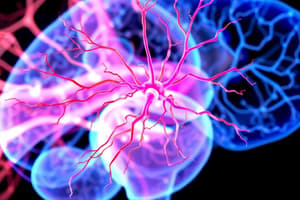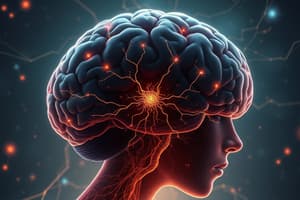Podcast
Questions and Answers
What is the primary inheritance pattern of spinocerebellar ataxia?
What is the primary inheritance pattern of spinocerebellar ataxia?
- X-linked dominant
- Autosomal dominant (correct)
- Autosomal recessive
- Mitochondrial
What is the underlying cause of spinocerebellar ataxia?
What is the underlying cause of spinocerebellar ataxia?
- Expansions of CAG repeat sequences in specific genes (correct)
- Duplications of the Alzheimer's gene
- Mutations in the Huntington gene
- Deletions of the Parkinson's gene
Which of the following is NOT a symptom of spinocerebellar ataxia?
Which of the following is NOT a symptom of spinocerebellar ataxia?
- Fever (correct)
- Difficulty with speech and swallowing
- Vision problems
- Muscle weakness and wasting
What is the primary role of electromyography (EMG) in the diagnosis of spinocerebellar ataxia?
What is the primary role of electromyography (EMG) in the diagnosis of spinocerebellar ataxia?
What is the name of the gene responsible for spinocerebellar ataxia type 3?
What is the name of the gene responsible for spinocerebellar ataxia type 3?
What is the goal of physical therapy in the management of spinocerebellar ataxia?
What is the goal of physical therapy in the management of spinocerebellar ataxia?
Which of the following is NOT a type of spinocerebellar ataxia?
Which of the following is NOT a type of spinocerebellar ataxia?
What is the primary purpose of genetic testing in the diagnosis of spinocerebellar ataxia?
What is the primary purpose of genetic testing in the diagnosis of spinocerebellar ataxia?
Study Notes
Definition and Overview
- A group of progressive, degenerative neurological disorders affecting the cerebellum and spinal cord
- Characterized by ataxia (loss of coordination and balance), muscle weakness, and other symptoms
Causes and Inheritance
- Autosomal dominant inheritance pattern in most cases
- Caused by expansions of CAG repeat sequences in specific genes (e.g., ATXN1, ATXN2, ATXN3)
- These expansions lead to the formation of toxic protein aggregates that damage brain cells
Symptoms and Progression
- Ataxia (loss of coordination and balance)
- Muscle weakness and wasting
- Difficulty with speech and swallowing
- Vision problems
- Seizures (in some cases)
- Cognitive impairment (in some cases)
- Symptoms worsen over time, leading to loss of independence and mobility
Diagnosis
- Clinical evaluation and medical history
- Genetic testing to identify the specific mutation
- Imaging studies (e.g., MRI) to rule out other conditions
- Electromyography (EMG) and nerve conduction studies to assess muscle and nerve function
Treatment and Management
- No cure, but various therapies and interventions to manage symptoms and improve quality of life
- Physical therapy to maintain muscle strength and mobility
- Speech therapy to improve communication
- Occupational therapy to adapt to daily activities
- Medications to manage associated symptoms (e.g., seizures, spasticity)
Types of Spinocerebellar Ataxia
- Spinocerebellar ataxia type 1 (SCA1): one of the most common forms, caused by an expansion in the ATXN1 gene
- Spinocerebellar ataxia type 2 (SCA2): another common form, caused by an expansion in the ATXN2 gene
- Spinocerebellar ataxia type 3 (SCA3): also known as Machado-Joseph disease, caused by an expansion in the ATXN3 gene
- Other rare forms of SCA, each caused by expansions in different genes
Definition and Overview
- Spinocerebellar ataxia is a group of progressive and degenerative neurological disorders that affect the cerebellum and spinal cord.
- The primary symptoms of spinocerebellar ataxia include ataxia (loss of coordination and balance), muscle weakness, and other associated symptoms.
Causes and Inheritance
- Spinocerebellar ataxia follows an autosomal dominant inheritance pattern in most cases.
- The disease is caused by expansions of CAG repeat sequences in specific genes, such as ATXN1, ATXN2, and ATXN3.
- These expansions lead to the formation of toxic protein aggregates that damage brain cells.
Symptoms and Progression
- Ataxia is the primary symptom of spinocerebellar ataxia, leading to a loss of coordination and balance.
- Muscle weakness and wasting are common symptoms, often resulting in muscle atrophy.
- Difficulty with speech and swallowing is another common symptom, which can lead to malnutrition and dehydration.
- Vision problems, including double vision, blurred vision, and loss of peripheral vision, are also common.
- Seizures occur in some cases, particularly in people with spinocerebellar ataxia type 2 (SCA2).
- Cognitive impairment, including decreased cognitive function and memory loss, is seen in some cases.
- Symptoms worsen over time, leading to a loss of independence and mobility.
Diagnosis
- A diagnosis of spinocerebellar ataxia is made through a combination of clinical evaluation, medical history, and genetic testing.
- Genetic testing is used to identify the specific mutation causing the disease.
- Imaging studies, such as MRI, are used to rule out other conditions that may be causing the symptoms.
- Electromyography (EMG) and nerve conduction studies are used to assess muscle and nerve function.
Treatment and Management
- There is no cure for spinocerebellar ataxia, but various therapies and interventions can help manage symptoms and improve quality of life.
- Physical therapy is used to maintain muscle strength and mobility.
- Speech therapy is used to improve communication and address speech and swallowing difficulties.
- Occupational therapy is used to adapt to daily activities and promote independence.
- Medications may be used to manage associated symptoms, such as seizures and spasticity.
Types of Spinocerebellar Ataxia
- Spinocerebellar ataxia type 1 (SCA1) is one of the most common forms, caused by an expansion in the ATXN1 gene.
- Spinocerebellar ataxia type 2 (SCA2) is another common form, caused by an expansion in the ATXN2 gene.
- Spinocerebellar ataxia type 3 (SCA3), also known as Machado-Joseph disease, is caused by an expansion in the ATXN3 gene.
- Other rare forms of spinocerebellar ataxia are each caused by expansions in different genes.
Studying That Suits You
Use AI to generate personalized quizzes and flashcards to suit your learning preferences.
Description
This quiz covers spinocerebellar ataxia, a group of progressive neurological disorders affecting the cerebellum and spinal cord, characterized by ataxia, muscle weakness, and other symptoms. It also delves into the causes and inheritance patterns of this condition.




